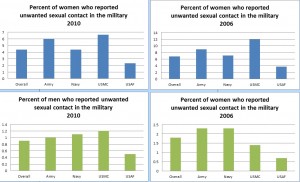
Newly released Department of Defense survey shows number of unwanted sexual contact incidents declining since 2006. Gina Harkins/MNS
WASHINGTON – Survey results released this month show that 4.4 percent of women and 1.1 percent of men in the Navy reported unwanted sexual contact in 2010, down significantly from 2006. Some senior military officials attributed the drop to increased training, but said further training still is needed, especially for lower ranks.
In the Department of Defense survey, the Navy fared second -lowest in claims of unwanted sexual contact; one-third of all military members responded to the survey. The Marines had the highest rate of unwanted sexual contact at 7.8 percent, with the Army respondents reporting 7 percent. The Air Force had the lowest rate, 2.8 percent.
The survey was last administered to active-duty members of the military in 2006, when 9.4 percent of Navy personnel reported unwanted contact. The Air Force one again had the lowest rate of 4.4 percent, compared with the Army at 11.2 and the Marines at 13.3 percent.
In 2006, 7.1 percent of women and 2.3 percent of men in the Navy reported the unwanted contact.
In an advisory meeting for the Department of Defense on women in the military, members discussed how to continue to bring the numbers down. Training sessions on sexual assault prevention and response became institutionalized in all branches of the military in 2005, but the committee acknowledged that they need to be stepped up if the rates are to continue the downward trend.
Diana Rangoussis, senior policy adviser with the Sexual Assault and Prevention Response Office, said the training needs to reach all ranks of the military, from the bottom up.
Those most vulnerable to sexual assault continue to be young, lower-ranked personnel. Male offenders tend to be the norm and they also tend to be the victims’ co-workers.
“Training is an area that we all agree needs a lot of work,” Rangoussis said. “The focus is really that the training be interactive and not just visual death by PowerPoint.”
At the San Diego Navy Base, interactive training is being used, according to Mary Kirby, Fleet and Family Support Center director. In addition to the general mandatory training courses presented to all military personnel on-base, Kirby said sailors have the option of becoming victim advocates.
“Every command here has a victim advocate,” Kirby said. “They volunteer or are appointed and they receive 30 hours of training on how to assist victims. We have a lot of dedicated people in our ranks, and they carry cell phones with them so they can always be reached if needed.”
But members of the military face different problems than civilians when it comes to experiencing sexual abuse, which can prevent them from reporting the crimes, according to Carolyn Allard, program director at San Diego VA’s Military Sexual Trauma Clinic. She said she sees higher levels of post-traumatic stress disorder in military victims of sexual abuse.
”It’s not only a workplace, but it’s also a family,” Allard said. “It’s not only post-traumatic stress disorder, but more complex forms of trust issues and self-blame issues.”
She said sexual assault training of any kind is best when the emphasis is on prevention, instead of response to unwanted contact.
Kirby said the training offered at the naval base in San Diego does both. The Department of Defense continues to offer various means to get in touch with someone anonymously in the event of sexual assault, including a hotline, text messaging and secure online instant messaging.
